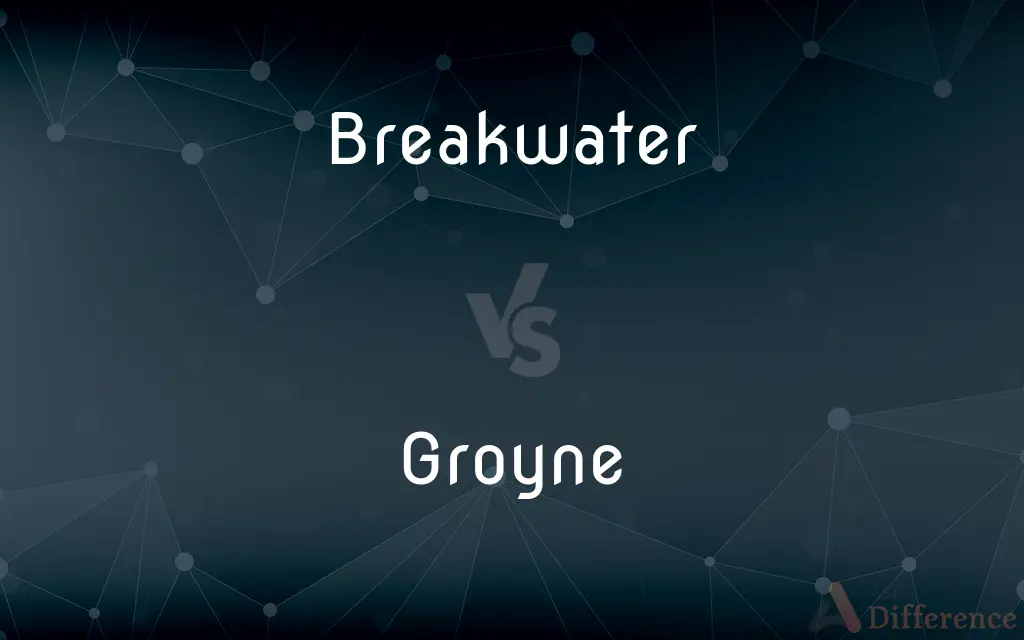Breakwater vs. Groyne — What's the Difference?
By Tayyaba Rehman & Urooj Arif — Updated on March 27, 2024
Breakwaters are structures built offshore to protect coastlines from erosion and storm damage, while groynes are built perpendicular to the shore to prevent beach erosion.

Difference Between Breakwater and Groyne
Table of Contents
ADVERTISEMENT
Key Differences
Breakwaters are large offshore structures designed to absorb and mitigate the force of waves before they reach the shore, thereby protecting coastlines, harbors, and anchorages from erosion and storm damage. On the other hand, groynes are structures built from the coast into the sea, intended to trap sand and sediment moving along the shore, thus preventing beach erosion and aiding in beach maintenance. While breakwaters focus on buffering the impact of incoming waves to protect a broader area, groynes specifically target the preservation of beaches by interrupting the natural lateral movement of sediment.
Breakwaters can be floating or fixed and are usually positioned parallel to the shoreline at a distance, creating a calm water area between the breakwater and the coast. This setup not only protects the shore but also creates safe harbors for boats and ships. Groynes, however, are typically constructed perpendicular to the shore and work by capturing sand that moves along the coast due to longshore drift, thereby maintaining or increasing the width of beaches. The effectiveness of groynes is highly visible in their ability to accumulate sand on one side, leading to a wider beach area.
The construction material and design of breakwaters and groynes can vary. Breakwaters often consist of large rocks, concrete blocks, or specially designed caissons that disperse the energy of waves. Groynes, on the other hand, may be made from timber, rock, concrete, or other durable materials, with their design and length carefully planned to maximize sand capture without adversely affecting neighboring stretches of the beach.
One of the critical differences between breakwaters and groynes lies in their environmental impact. Breakwaters can significantly alter local marine environments by changing water flow and sediment patterns, sometimes leading to unintended erosion in other areas. Groynes, while beneficial for beach preservation, can also disrupt natural sediment flows, potentially causing erosion downstream of the groyne. Both structures must be carefully planned and monitored to balance their protective benefits with potential environmental consequences.
While both breakwaters and groynes are coastal engineering structures designed to combat erosion, their methods, purposes, and impacts differ significantly. Breakwaters aim to protect broader coastal areas by calming waves before they reach the shore, whereas groynes focus on preventing beach erosion by capturing and retaining sediment moving along the shore.
ADVERTISEMENT
Comparison Chart
Purpose
Protect coastlines and harbors from erosion and storm damage.
Prevent beach erosion by trapping sand and sediment.
Location
Built offshore, parallel to the coastline.
Built perpendicular to the shore, extending into the sea.
Function
Absorbs wave energy to create calm waters near the shore.
Interrupts longshore drift to accumulate sand on the beach.
Construction
Often made of large rocks, concrete blocks, or caissons.
Typically constructed from timber, rock, or concrete.
Environmental Impact
Can alter marine environments and water flow, potentially causing erosion elsewhere.
May disrupt natural sediment flows, causing erosion downstream.
Compare with Definitions
Breakwater
Requires careful planning to avoid adverse environmental impacts.
Environmental studies were conducted before the breakwater construction began.
Groyne
Constructed perpendicular to the coastline, extending into the sea.
A series of groynes has been installed along the coast.
Breakwater
Often extends parallel to the shore at a distance.
The harbor's breakwater provides safe anchorage for boats.
Groyne
Works by interrupting sediment transport along the shore.
The groynes have effectively stopped sand from being washed away.
Breakwater
Can be floating or fixed, depending on the design and purpose.
The floating breakwater can be adjusted as needed.
Groyne
A barrier built to prevent beach erosion by trapping sand.
The groyne has helped maintain our beach's sand levels.
Breakwater
A structure designed to protect a coast from the force of waves.
The new breakwater has significantly reduced coastal erosion.
Groyne
Can cause sediment accumulation on one side, affecting nearby areas.
The groyne has caused a buildup of sand on its western side.
Breakwater
Aims to create calm water areas for harbors and coastal protection.
The calm waters behind the breakwater are ideal for swimming.
Groyne
Made from various materials like timber, rock, or concrete.
The new timber groynes blend well with the natural landscape.
Breakwater
A barrier that protects a harbor or shore from the full impact of waves.
Groyne
A groyne (in the U.S. groin), built perpendicular to the shore, is a rigid hydraulic structure built from an ocean shore (in coastal engineering) or from a bank (in rivers) that interrupts water flow and limits the movement of sediment. It is usually made out of wood, concrete, or stone.
Breakwater
A construction in or around a harbour designed to break the force of the sea and to provide shelter for vessels lying inside.
Groyne
Variant of groin2.
Breakwater
(nautical) A low bulkhead across the forecastle deck of a ship which diverts water breaking over the bows into the scuppers.
Groyne
An often wooden structure that projects from a coastline to prevent erosion, longshore drift etc.; a breakwater.
Breakwater
(on beaches) A wooden or concrete barrier, usually perpendicular to the shore, intended to prevent the movement of sand along a coast.
Groyne
See Groin.
Breakwater
Any structure or contrivance, as a mole, or a wall at the mouth of a harbor, to break the force of waves, and afford protection from their violence.
Groyne
A protective structure of stone or concrete; extends from shore into the water to prevent a beach from washing away
Breakwater
A protective structure of stone or concrete; extends from shore into the water to prevent a beach from washing away
Common Curiosities
How do groynes prevent beach erosion?
By trapping sand and sediment moving along the shore, preventing it from being washed away.
Where are breakwaters typically located?
Offshore, parallel to the coastline, to buffer against incoming waves.
What is the main purpose of a breakwater?
To protect coastlines and harbors from erosion and storm damage by absorbing wave energy.
What is the difference between floating and fixed breakwaters?
Floating breakwaters can be adjusted and moved, whereas fixed breakwaters are permanently anchored.
How do breakwaters and groynes impact beach width?
Breakwaters protect the coast, allowing natural sand accumulation, while groynes directly increase beach width by trapping sand.
What materials are used to construct groynes?
Groynes can be made from timber, rock, concrete, or other durable materials.
Why are groynes built perpendicular to the shore?
To effectively interrupt longshore drift and accumulate sand on the beach.
Can groynes affect neighboring beaches?
Yes, by trapping sand, they can reduce sediment supply to adjacent beaches, potentially leading to erosion.
What factors influence the design of a breakwater?
Factors include coastal wave patterns, local marine environments, and the specific protection needs of the area.
Can breakwaters affect local marine environments?
Yes, they can alter water flow and sediment patterns, potentially causing unintended erosion elsewhere.
How is the effectiveness of a breakwater measured?
By its ability to reduce wave energy and protect the coastline or harbor behind it.
Are there environmental concerns with constructing groynes?
Yes, they can disrupt natural sediment flows and potentially cause erosion in areas downstream of the groyne.
Is it possible to have both breakwaters and groynes in the same area?
Yes, combining both can provide comprehensive coastal protection by addressing both offshore wave energy and beach erosion.
How long do groynes last?
The lifespan varies based on materials and environmental conditions but can last several decades with maintenance.
How do communities decide between building a breakwater or a groyne?
The decision is based on the specific erosion issues faced, budget, environmental impact considerations, and long-term maintenance needs.
Share Your Discovery

Previous Comparison
Ft vs. Mt
Next Comparison
Anesthesia vs. AnaesthesiaAuthor Spotlight
Written by
Tayyaba RehmanTayyaba Rehman is a distinguished writer, currently serving as a primary contributor to askdifference.com. As a researcher in semantics and etymology, Tayyaba's passion for the complexity of languages and their distinctions has found a perfect home on the platform. Tayyaba delves into the intricacies of language, distinguishing between commonly confused words and phrases, thereby providing clarity for readers worldwide.
Co-written by
Urooj ArifUrooj is a skilled content writer at Ask Difference, known for her exceptional ability to simplify complex topics into engaging and informative content. With a passion for research and a flair for clear, concise writing, she consistently delivers articles that resonate with our diverse audience.














































